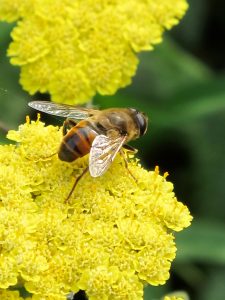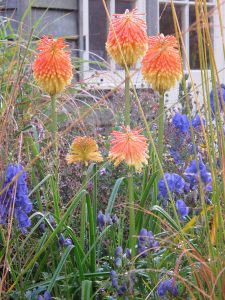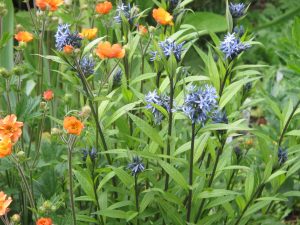I know! I admit that I have too many plant passions for my own good. It begins with snowdrops, goes on to hellebores and then there are my hardy ferns, erythroniums and trilliums. Once summer arrives, it’s peonies, roses and phloxes all the way, and then my beloved dahlias take up the baton. Weather permitting, they can go on into November. However, the really important plants in my garden are the ones that return every year and perform whatever the conditions. These are the plants than make the seasons sing. They are the crème de la crème, and they form the backbone of my planting.

Early summer sees two pallid-yellows spin into action and this colour runs through the border like ‘a spinning thread’, a phrase coined by the late nurserywoman Beth Chatto (1923 -2018). The first to flower is an achillea named ‘Moonshine’ and it combines silvery filigree foliage and domes of acid-yellow flowers that begin in May and carry on, in flushes, to late autumn. No other achillea flowers so prolifically for so long. I couldn’t be without it!
‘Moonshine’ was raised and named by the late, great Alan Bloom (1906-2005) of Bressingham Gardens in Norfolk. He often told me that it was his favourite plant of the hundred or so he named, although sometimes he veered off-piste towards a crocosmia he named ‘Lucifer’. Alan gave many of his plants the Bressingham prefix, or named them after long serving staff. However, if he had a stand-out plant he would look for a commercially popular name instead. Hence ‘Lucifer’ and ‘Moonshine’.
Mr Bloom, as his staff called him, had a wonderful eye for a plant and he was the first nurseryman to travel the Continent. As a result, he introduced many fine plants raised by German and Swiss plant breeders. He anglicised their names, because he released them not long after the Second World War. He gave us a sedum called ‘Autumn Joy’, and two penstemons which he called ‘Garnet’ and ‘Firebird’. They’ve reverted to their German names ‘Herbstfruede’, ‘Andenken an Friedrich Hahn’ and ‘Schoenholzeri’ respectivey.
The domed, flat heads of Achillea ‘Moonshine’ add extra shape and contrast to simpler shaped flowers, as do all achilleas. Beth Chatto always talked about ‘cadence and contrast’ and it’s pleasing on the eye to mix the shapes and textures of both leaf and flower. This also helps pollinators, because they have their own flower preferences. The tiny individual flowers found on an achillea head suit the tiny mouths of hoverflies. Most of the hoverflies found in our gardens are beneficial. because their larvae predate aphids and whitefly.
There is one drawback to ‘Moonshine’ and this is where a Hartley greenhouse will definitely come in useful. ‘Moonshine’ must be propagated every three years or so, to prevent it becoming woody at the base. Pull away a couple of pieces from the base in spring, if you can. These slips will almost certainly have a little bit of root at the base. Plunge the pieces into damp coarse horticultural sand and you can use pots or small seed trays. Place you Irishman’s cuttings, as the slips with roots are called, at the back of your greenhouse. No offence to Irishmen intended by the way!

If there isn’t any basal growth, take some of the tips, but make sure that the stems are not too soft. Soft material never roots: it must have some spring and pliability. ‘Bendy Wendies’ make the best semi-ripe cuttings. These tips can also be rooted in coarse horticultural sand. However, this simple technique doesn’t work with fine sand, because it doesn’t hold enough moisture. The sand must contain horticultural grit and the sand must be kept damp but not waterlogged.
My other star performer can also be propagated in this way, but only if you need more or the original plant has weakened. It’s a lucid-yellow daisy named Anthemis tinctoria ‘E.C. Buxton’. This wonderful plant dates back roughly a hundred years or so and it initially popped up in a garden owned by E.C. Buxton’s in Capel Curig, northwest Wales. It was distributed by his close neighbour, A. T. Johnson of Geranium ‘Johnson’s Blue’ fame.
When it rains in northwest Wales, it does so with conviction, so this resilient anthemis is able to shrug off winter wet far better than most other anthemis. The finely cut foliage is a darker green and the stems are topped by large yellow daisies. At midday these resemble spinning plates, but their petals head downwards as light levels fall, just as though they are sulking. Several pop up in the border leading to my front door, and it’s worth saying that ‘daisy’ is a corruption of ‘day’s eye’ – a sunny position is compulsory for most of them.
If you want a later pallid-yellow daisy Helianthus ‘Lemon Queen’ should light up the garden from August onwards. I say ‘should’ because this tall daisy can fail in dry summers and we seem to be getting more of those in recent years. That can be said of many later flowering plants now that summers are hotter and drier. This tall daisy makes larger clumps, so it’s not suited to a small plot.
If you’re using soft-yellows, the touchpaper partners come in shades of blue and purple. The metre-high New England Aster, Symphyotrichum novae-angliae ‘Helen Picton’, is the perfect partner for ‘Lemon Queen’. It’s a New England aster and these butterfly magnets flower in September. They often come with a speckled wood. Better still, New England asters are easy to grow, because they can survive drier conditions than most North American asters.
The New Englanders have stiff woody stems, so they stand up to weather very well, and they don’t need regular division either. They tolerated last year’s hot, dry summer really well, although they flowered three weeks later than usual. Most are pink or white, so the purple ‘Helen Picton’ is a colourful breakthrough. The nick in their armour, and there’s always one, is a tendency for the stems to look shabby just before the flowers appear. Place them in the middle of the border to hide their untidy legs.

If you’re using purple don’t be afraid to add some orange as well. My two go-to oranges for the first part of summer are Geum ‘Totally Tangerine’ and Helenium ‘Sahin’s Early Flowerer’. They’re probably the two best plants to emerge within the last twenty or so years and they’re both sterile hybrids. This means that they repeat flower over many weeks, because a pollen incompatibility prevents them from setting seeds.
Both were made commercially available through tissue culture, but once planted both will divide easily in the garden setting. Spring division is best, as they begin to grow again. If you replant them back into garden soil straight away, do water the divisions in dry springs. You can also pot up your divisions.
The arrival of these two plants illustrates the difference in their provenance. ‘Totally Tangerine’ was introduced by Hardy’s Cottage Garden Plants at Chelsea in 2010, but it was raised by Tim Crowther of Warburtons Nursery in Sussex over a period of twenty years. The complicated double cross began life in 1988 when Tim crossed G. coccineum and G. rivale. The best seedlings were crossed with G. chiloensis. ‘Totally Tangerine’ flowers from May until November. Fluffy orange-brown seed heads follow, resembling russet-legged spiders, and they add great charm to late-autumn days. I grow lots of it with a grey-blue amsonia and it’s come through wet winters, severe winters and drought to perform brilliantly for me, regularly producing hundreds of flowers a year.
‘Sahin’s Early Flowerer’ arrived by serendipity or chance. It appeared in a Dutch seedsman’s field among thousands of heleniums being raised as a seed crop. One plant flowered from May until September and the late Kaas Sahin, recognising its potential, passed it on to Bob Brown of Cotswold Garden Flowers. It’s a sterile hybrid, hence the vigour and long-flowering season. I couldn’t garden without any of these star plants!



